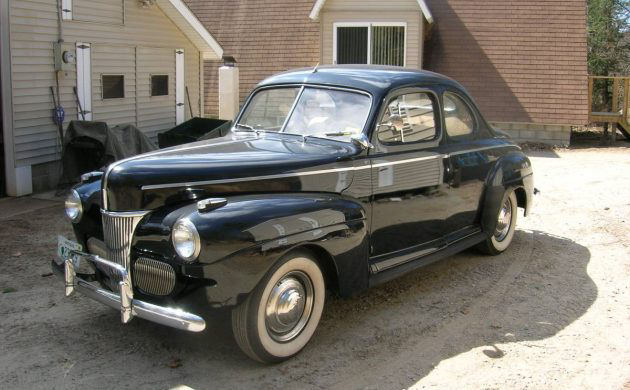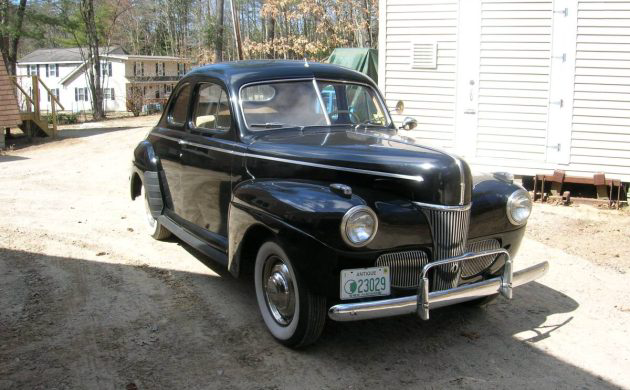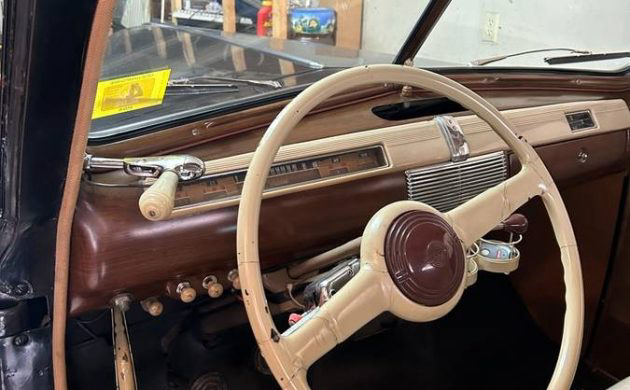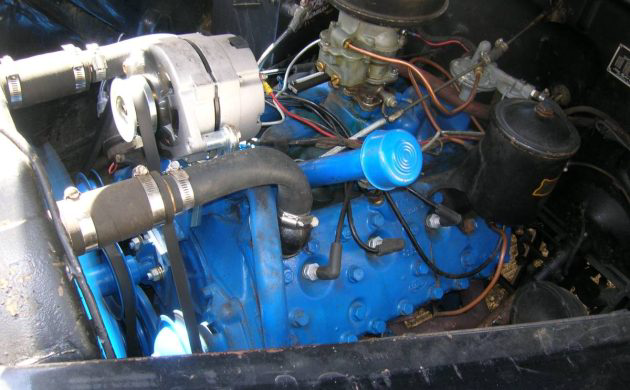We live in great times when it comes to automobile reliability. With long warranties, closer manufacturing tolerances, and commonality of parts even among different makes, it is easy to find used cars with over 200,000 miles on them. Engine rebuilding is also not nearly as common as it used to be. Not too long ago, a car with 100,000 miles was considered worn out. If you wanted to keep driving, your tired engine could be exchanged for a rebuilt one not only at a dealership, but at places like Sears, Montgomery Wards, Western Auto, and many smaller shops. These engines were usually painted a different color than stock so they could be easily identified. That may be what happened with this 1941 Ford Business Coupe. This one, however, comes with both the later unit and the original engine. Does the newer Flathead with a rebuild make you more likely to consider this coupe?
The 1941 Ford you see here is currently powered by a rebuilt Flathead V-8 manufactured in 1952. Painted Ford Corporate Blue, this engine is said to displace 239 cubic inches and puts out 110 horsepower, which is a significant step up from the original Flathead’s 85 horsepower. The blue paint is interesting, as Ford decided to paint all of its engines this color in 1966. Dark green or dark blue would be the proper color for a 1941 block. For a 1952 block, green or tangerine would be correct. Was this engine rebuilt later, when Ford Corporate Blue became the standard? Hopefully, we will hear from our long-time readers and Ford experts in the comments as to their thoughts on the blue paint’s significance.
The seller tells us that the car has been upgraded to a 12-volt electrical system with a single-wire alternator and a Pertronix electronic ignition kit. A rebuilt three-speed transmission with a column shifter handles transmitting power to the stock Ford rear end. This Ford will also come with its original 85-horsepower Flathead V-8. The older engine is in excellent condition, but it will need to have its crankshaft ground and “new rod and bearings.” Perhaps what the seller is telling us is that it comes with the original block in good condition, but a rebuild with new bearings is necessary if the buyer intends to put it back in place.
Looking inside, we can see that the dash is in good condition. The ivory-colored plastic you see on the dash is likely made up of reproduction parts. Original pieces were made of Bakelite. This was an early form of plastic that cracked and shrank as it aged and was more brittle than the plastics we use today. The seller tells us that the radio is missing, but we do see that an optional clock is present in the glove box door. We can also see that the car is equipped with a spotlight, which is a rare option. As for the interior, it is in useable condition and maybe even better with some cleaning. While not original, the interior you see is a replacement from 20 years ago.
The seller does warn us that the car will need metal work behind both the running boards and the front fenders. As for the paint, the car came from the factory with dark green paint but was painted black by a previous owner. We are also told that the frame is good and that the tires are very good. The brakes are described as a “new original drum.” Most likely that means that the car has been treated to rebuilt wheel cylinders and maybe even a rebuilt master cylinder with some relining of the brake shoes thrown in. Topping things off is a set of blue dot taillights to give the car a touch of the old school custom look.
As a whole, this 1941 Ford business coupe should be a good driver and is in very presentable condition. 1941 Fords tend to be less desirable than earlier Fords, particularly the 1932, 1934, 1936, and 1940 models. They are, however, very good drivers and provide a bit more modern driving experience. The price of this car may be outside the norm for a car in this condition. The good news is that a phone call costs next to nothing. When two people sit down and talk, anything is possible.
If you are looking for a driver-level prewar car, then this 1941 Ford coupe for sale on Craigslist in Northfield, New Hampshire should be on your shortlist. This coupe is being offered at $25,000. Thanks to Mitchell G. for this prewar Ford find!








Does anyone else hate the blue dots, or just me? Seriously wondering
I love them. Always have, and I’m 79.
I seem to remember that Ford undertook a rebuilding program designed to rebuild as many flathead
V-8s as they could after WWII to keep
their customers cars on the road a while longer while Detroit changed over from building war supplies to making cars again. As a young man I
saw a lot of these postwar rebuilt engines while helping my Dad and his
friends work on whatever project they
were doing back then. These postwar
flatties were a hodgepodge of Ford
parts from ’32-45 that were put use
as part of this massive undertaking.
Back then, a flathead was a flathead
and most everything was pretty much
universal. It wasn’t uncommon to see
say a ’37 block retrofitted with a mix of ’30s and ’40s parts. That ’37 block
could have ’40 innards with ’39 heads,
a ’36 carb, along with with a ’38 distributor and a ’41 generator. As for
the blue color on the rebuilt block, I think the seller painted it himself to make it look different. In fact, I’ve seen these rebuilt units were sometimes painted black on the block with red cylinder heads though I
don’t know who was selling these engines painted this way. It was one
of the greatest recycling programs
that actually worked.
Most pre 1955 engines had the bearings “poured” into the casting and then clearance was set up with shims. I like anything old and this definitely has a cool factor to it.
Babbitt bearings were pretty much obsolete by the mid 1930s for autos. They are still used in some industrial applications. I believe Ford went to insert bearings about 1937.
I had a 53 with a 239 flathead and the motor was red. No idea whether that was the factory color or not for that year.
“blue dots” were illegal (?) in mid-’50s HS (WA). The HORROR! Meth had not surfaced … just “Oly” and “Rainier” …
The motor in the pic is an 8BA or 49 to 53 vintage. A much better one than the original and a popular replacement. I am concerned about the upper radiator hose kinking. It could be a reliable daily driver for someone.
The color of the engine doesn’t always indicate when it was made or re-built.The engine could have been painted that blue anytime after the color was available, for a bit of dress-up, or refresh (aka aerosol overhaul).
With just that one pic it is hard to tell for sure. Looking for over spray, etc, that indicates that it was painted in place, rather than during a rebuild. I see a few things that tell me it wasn’t painted last week, but nothing to say it was done a few years ago.
Nice car here. We paint our British race engines Chevy orange to brighten up the engine compartment so we can see any leaks or damage. Did have a couple of folks ask me why the color and not the British military green. Told them because it wasn’t an army truck.
This is a very nice example of a 1941 Ford. It’s interesting that they were never considered desirable, the 40 Fords were always more popular along with just about every other pre-WWII Ford. Which really doesn’t make sense as there were so few 1942 Fords. How and why the car culture decides what’s cool I have no idea? I think 25 K is fair for this car, but it might be a stretch to get it.